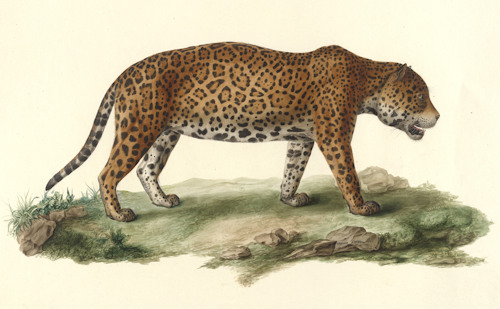
The National Library’s special exhibition in the magnificent state hall explores the role of (wild) animals at the Vienna court with a focus on their depiction across several centuries.
- A mix of art and history in a venue worth visiting in its own right
- Particular highlights are pictorial works from Emperor Ferdinand I’s collection
- Runs Mar 24 – Jun 26, 2022
- See also:
- The national library’s state hall
- Current exhibitions in Vienna
Paintings from the Habsburg Collections

(Male jaguar; Leopold Stoll; watercolour; 1820 © Österreichische Nationalbibliothek)
As you might imagine, Austria’s national library has more than faded comics and a 1974 Guide to Salzburg in its archives. Their extensive and prestigious collections include those put together in imperial times and provide a rich resource for regular temporary exhibitions.
The latest such event presents depictions of animals across four centuries, but does more than just showcase the artistic representations.
The exhibition The Emperor’s Most Beautiful Animals also highlights the role played by native and non-indigenous creatures in historical court life, whether in private zoos and households, scientific collections or as plunder from foreign expeditions.
So we get to see, for example, pictures of long-lost menageries like the one Prince Eugene kept at Belvedere.
Or learn about the early 19th-century expedition to Brazil that saw thousands of specimens sent back for evaluation by the staff of the court’s Hof-Naturalienkabinett (the same expedition features in the current special exhibition at the Natural History Museum).
Or discover the horrors of the 18th-century Hetztheater, which entertained crowds with animal fights until the emperor stepped in to ban the practice.
Nevertheless, the focus lies on the representations of the animals themselves.
As well as possessing intrinsic artistic value, the pictorial works also represent several centuries of endeavour in natural history. And they reflect the motivations of the patrons: the need or prestige, scientific curiosity or simply a love of animals.
In particular, the exhibition has around 40 highlights from a huge collection of almost 10,000 animal watercolours belonging to Emperor Ferdinand I (1793-1875). These feature the art of specialist painters working with the Hof-Naturalienkabinett in the early 1800s.
Tickets & dates
Get a glimpse of the animals from March 24th to June 26th, 2022. An entrance ticket to the state hall includes the exhibition.
Consider the temporary displays as icing on a Baroque cake: the state hall or Prunksaal is the kind of library you see touted on Instagram or Twitter as one of the world’s most beautiful. And rightly so.
Those with an interest in natural history (with an emphasis on history) should take time to visit the appropriately-named Natural History Museum, whose upper level includes numerous preserved animals from late Habsburg times.
And those with a fondness for Habsburg art collections should visit the Natural History Museum’s twin: the Kunsthistorisches Museum has an extensive paintings gallery full of old masters.
And, of course, one of those early menageries (established out in the country by Emperor Franz Stephan in the mid-1700s) is today’s Schönbrunn Zoo: the oldest working zoo in the world.
How to get to the exhibition
See the main state hall article for travel tips. It’s within the Hofburg complex that dominates part of the centre of town.
Address: Josefsplatz 1, 1010 Vienna